Sachsenhausen Memorial and Museum
Berlin is an amazing city. I'll write about it later, but I'm going to write first about the last place we went.
I returned home last night to an email message from Keith, Laura's boyfriend. He's writing a paper about heterosexism and wondered if I had any comments.
I had some. Yesterday before we left Germany, Ian and I went to Sachsenhausen, which, from 1936 to 1945 was a Nazi death camp.
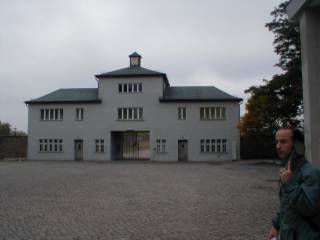
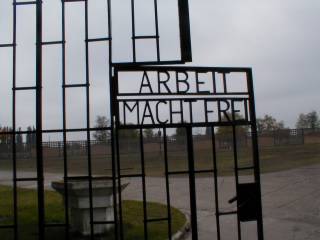
Work will make you free...
Rev. Martin Niemoller was one of those held here. He is credited with (possibly) writing the following:
Luckily, Rev. Niemoller made it out alive. When asked about whether the camp was really as bad as all that, he said something to the effect that as bad as you think it might have been, it was 1,000 times worse.
Although he lived, over 100,000 died in Sachsenhausen - many of them homosexual.
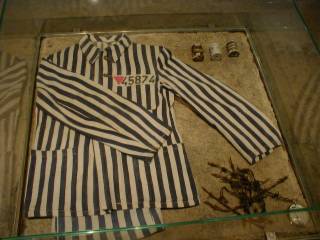
45874 - the number of a victim - and his uniform with a pink triangle, the symbol gays had to wear in the concentration camps.

This is the pathology building where victims were experimented on and autopsied before being cremated and buried in the mass graves.
Sachsenhausen was not unusual in the brutality shown to those who were its victims, but its memorial is unusual in that it's one of the very few that actually acknowledges that many of those who were murdered there died because they were homosexual. That's a good thing for any Nazi death camp memorial to acknowledge.
Still, although this was acknowledged we saw no "signs of commemoration" (the term used by the Sachenhausen Memorial and Museum) to the dead homosexuals.
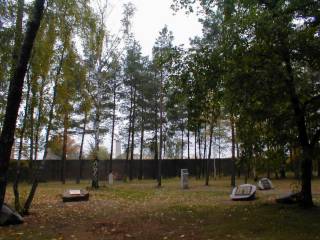
There were memorials (in the form of bronze sculptures or markers) to the dead Jehovah's Witnesses, to the political prisoners, to the Jews and to the prisoners of war who were captured. There were memorials to any number of those who were killed because they were identified as being this or that. But none to homosexuals. I got a little angry about that. Why were the murdered homosexuals excluded?
While you're pondering this, remember that this is Europe we're talking about, not Kansas. It's not because homosexuals aren't accepted - well, ok, tolerated - here. They are. Ian and I are marrying each other next April. So yes, we can legally marry. But there's still not yet a memorial for those murdered because they were homosexual?
Why?
I still haven't figured this out but I think it's important, and I think it's linked with heterosexism.
Although I see that heterosexism is damaging, I don't think that heterosexism is, by nature, hateful; at least not in the way homophobia is. Does that matter? Does intent matter when people are hurt?
In criminal law, we define intent as an element of some crimes - murder, for instance. We also have crimes of negligence. In the simplest of terms, these are crimes where people are hurt through another's negligence. A damage that could have been prevented but for the thoughtlessness of another. However, in order for negligence to rise to an actionable level, the damage caused by the thoughtlessness must have been foreseeable.
Foreseeability to cause damage - this is the weak link when it comes to heterosexism's harm.
If one sees only through one's own orientation, how can one foresee damage to another who experiences a differing orientation? This goes beyond sexuality. Inablility to empathise with another's position in life is arguably the largest cause of race, gender, religion and other discriminatory practices.
The solution must be education. We must continually educate and be educated to see from the eyes of another. Without this familiarity with other orientations, there is no forseeability, and without forseeability there is no negligence, no responsibility. That's how I perceive the problem and the solution, drawn with a very large brush.
An update: Since I wrote this, Ian's done some research and found that there is, in fact, a memorial to the gay men who died at Sachsenhausen.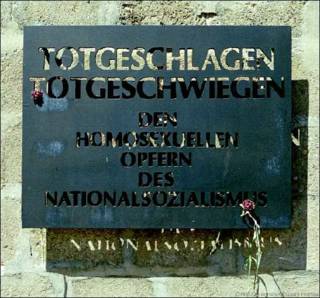
I'm not certain why we didn't see it. I would have thought that even though it's in German (the others were in English as well) we would have noticed it for what it was. After finding this, we looked a little deeper and found that although Sachsenhausen has this memorial, there are still camps that have no memorial whatsoever, nor do they acknowledge the gay men who died in the camps.
I returned home last night to an email message from Keith, Laura's boyfriend. He's writing a paper about heterosexism and wondered if I had any comments.
I had some. Yesterday before we left Germany, Ian and I went to Sachsenhausen, which, from 1936 to 1945 was a Nazi death camp.


Work will make you free...
Rev. Martin Niemoller was one of those held here. He is credited with (possibly) writing the following:
First they came for the Communists,
and I didn’t speak up,
because I wasn’t a Communist.
Then they came for the Jews,
and I didn’t speak up,
because I wasn’t a Jew.
Then they came for the Catholics,
and I didn’t speak up,
because I was a Protestant.
Then they came for me,
and by that time there was no one
left to speak up for me.
Luckily, Rev. Niemoller made it out alive. When asked about whether the camp was really as bad as all that, he said something to the effect that as bad as you think it might have been, it was 1,000 times worse.
Although he lived, over 100,000 died in Sachsenhausen - many of them homosexual.

45874 - the number of a victim - and his uniform with a pink triangle, the symbol gays had to wear in the concentration camps.

This is the pathology building where victims were experimented on and autopsied before being cremated and buried in the mass graves.
Sachsenhausen was not unusual in the brutality shown to those who were its victims, but its memorial is unusual in that it's one of the very few that actually acknowledges that many of those who were murdered there died because they were homosexual. That's a good thing for any Nazi death camp memorial to acknowledge.
Still, although this was acknowledged we saw no "signs of commemoration" (the term used by the Sachenhausen Memorial and Museum) to the dead homosexuals.

There were memorials (in the form of bronze sculptures or markers) to the dead Jehovah's Witnesses, to the political prisoners, to the Jews and to the prisoners of war who were captured. There were memorials to any number of those who were killed because they were identified as being this or that. But none to homosexuals. I got a little angry about that. Why were the murdered homosexuals excluded?
While you're pondering this, remember that this is Europe we're talking about, not Kansas. It's not because homosexuals aren't accepted - well, ok, tolerated - here. They are. Ian and I are marrying each other next April. So yes, we can legally marry. But there's still not yet a memorial for those murdered because they were homosexual?
Why?
I still haven't figured this out but I think it's important, and I think it's linked with heterosexism.
Although I see that heterosexism is damaging, I don't think that heterosexism is, by nature, hateful; at least not in the way homophobia is. Does that matter? Does intent matter when people are hurt?
In criminal law, we define intent as an element of some crimes - murder, for instance. We also have crimes of negligence. In the simplest of terms, these are crimes where people are hurt through another's negligence. A damage that could have been prevented but for the thoughtlessness of another. However, in order for negligence to rise to an actionable level, the damage caused by the thoughtlessness must have been foreseeable.
Foreseeability to cause damage - this is the weak link when it comes to heterosexism's harm.
If one sees only through one's own orientation, how can one foresee damage to another who experiences a differing orientation? This goes beyond sexuality. Inablility to empathise with another's position in life is arguably the largest cause of race, gender, religion and other discriminatory practices.
The solution must be education. We must continually educate and be educated to see from the eyes of another. Without this familiarity with other orientations, there is no forseeability, and without forseeability there is no negligence, no responsibility. That's how I perceive the problem and the solution, drawn with a very large brush.
An update: Since I wrote this, Ian's done some research and found that there is, in fact, a memorial to the gay men who died at Sachsenhausen.

I'm not certain why we didn't see it. I would have thought that even though it's in German (the others were in English as well) we would have noticed it for what it was. After finding this, we looked a little deeper and found that although Sachsenhausen has this memorial, there are still camps that have no memorial whatsoever, nor do they acknowledge the gay men who died in the camps.
Labels: Concentration Camp, Germany, Sachsenhausen, travel
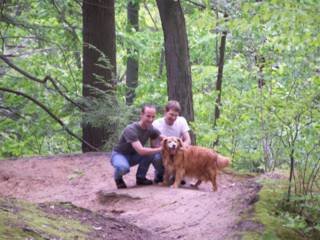

0 Comments:
Een reactie posten
<< Home